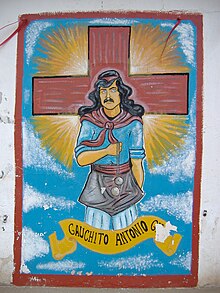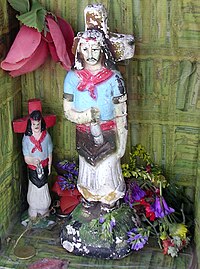This article has multiple issues. Please help improve it or discuss these issues on the talk page. (Learn how and when to remove these messages)
|
| Gauchito Gil | |
|---|---|
 A mural with a traditional depiction of the Gauchito Gil in a suburb of Rosario. A mural with a traditional depiction of the Gauchito Gil in a suburb of Rosario. | |
| Little Gaucho Gil, Gaucho Saint, Folk Saint of Argentina | |
| Born | 1840s, allegedly 1847 Mercedes (formerly Pay Ubre), Argentina |
| Died | 8 January 1878 Mercedes, Argentina |
| Venerated in | Folk Catholicism |
| Major shrine | Sanctuary of Gauchito Gil, Mercedes, Corrientes |
| Feast | January 8 |
| Attributes | Gaucho standing in front of a red cross, holding bolas or a red cross, red bandana, blue shirt, espinillo tree |
| Patronage | Gauchos, protection from harm, luck, fortune, good health, love, healing, outlaws, bravery, deserters, folk heroes, cowboys, safe passage |
The Gauchito Gil (literally "Little Gaucho Gil") is a folk religious figure from Argentina. His cult is inspired by the purported historical figure of Antonio Mamerto Gil Núñez (c. 1847–1878), whose existence is not reliably documented. He is currently regarded as the most prominent folk saint in Argentina, although sanctuaries devoted to his cult are also found in Bolivia, Chile, Paraguay, Uruguay, and Spain.
Legend
Antonio Gil was supposedly born in the 1840s near what is now the city of Mercedes (formerly "Pay Ubre") in the province of Corrientes, Argentina, where he grew up to become a gaucho. According to some accounts, in his youth he fought the local commissioner over the love of a woman—having pardoned the life of his rival, he was left with no choice but to leave town. According to a different version of the legend, after being conscripted to fight in the War of the Triple Alliance, one night Gil had a dream in which God told him not to kill innocent people. He consequently deserted the army, becoming a fugitive from justice. According to yet another version, in the civil wars that followed the War of the Triple Alliance he was a supporter of the Federalist Party, represented by the colour red, so when he was called up to fight in the ranks of the Unitarian army, he refused. Whatever the case, after fleeing from justice he went on to become a thief, perhaps a cattle rustler, who stole from the rich and helped the poor. He was eventually caught on January 8, 1878, and sentenced to hang upside down from an espinillo tree, where his neck would be cut off. Before dying, he told the executioner that upon arriving home he would find his son very ill, but that he could be saved from death if the executioner prayed for Gil's intercession. The man did as the Gauchito had told him and the son was miraculously saved. In gratitude, he returned to the spot where Gil had been executed, buried him, and erected a cross of espinillo wood, thus giving birth to the cult.

Veneration



Until the late twentieth century, devotion to Gauchito Gil was limited to the rural population of Corrientes, and was of little relevance nationwide. In the 1990s, however, his cult experienced a sudden growth among the Argentine urban working classes, particularly in the Greater Buenos Aires area, where large numbers of people from the provinces had recently arrived in search of better living conditions. Since outlaw saints are usually regarded as figures of resistance to authority and champions of the underclasses, Gauchito Gil's rise in popularity can be interpreted as a reaction to the neoliberal politics of the period (see Menemism). The spread of the cult throughout the country was mainly the work of devout truck drivers, who were also responsible for erecting many of the numerous roadside shrines dedicated to the saint. As of 2019, around 23% of Argentines considered themselves devotees of the Gauchito.
The main sanctuary of Gauchito Gil is located about 8 km from the city of Mercedes, at the alleged site of his execution, and houses an empty mausoleum (i.e., a cenotaph) dedicated to his memory. The mausoleum's walls are adorned with some fifty thousand plaques expressing gratitude for various miracles granted by the saint. To one side stands the tree where he was hanged. Offerings are left in the form of candles, red ribbons and flowers, cigarettes, and bottles of alcoholic drinks—things that the Gauchito is supposed to have liked when he was alive. The sanctuary's grounds cover about 5 hectares and are lined with stalls selling food, religious images, crosses, red ribbons and flags, rosaries, mates, facones, ponchos, and other souvenirs. The Mercedes sanctuary receives over 250,000 pilgrims a year, most of whom visit it for the saint's feast day on January 8. Festive activities on this date range from masses and processions to dancing, drinking, and horse-riding demonstrations.
Other major sanctuaries are located in the cities of Buenos Aires (Plaza Los Andes and Puente La Noria), Posadas, Rosario, and San Roque, among others, as well as in the suburbs of Buenos Aires (Bernal, Alejandro Korn, Troncos del Talar, etc.). Small roadside shrines painted red and decorated with red flags and ribbons can be found scattered all over Argentina's roads, with special prevalence in the north of the country.
Gauchito Gil is not recognized as a saint by the Catholic Church, though many Argentines, both devotees and church leaders, have been promoting him for canonization. Local church leaders in Mercedes hold masses on his feast day in the Church of Our Lady of Mercy. Other church leaders in Argentina have participated and approved of the devotion of Gauchito Gil, while some are divided on whether to embrace or condemn the phenomenon. The Diocese of Goya and the Mexican Diocese of Celaya have both recognized the veneration of Gauchito Gil.
See also
References
- ^ Carballo, Cristina Teresa (2018-06-18). "PAISAJES DEL GAUCHITO GIL EN BUENOS AIRES ¿NEOCULTURAS URBANAS DE FE?". Espaço e Cultura (43): 113–130. doi:10.12957/espacoecultura.2018.46781. ISSN 2317-4161.
- ^ Graziano, Frank (2007). Cultures of devotion: folk saints of Spanish America. Oxford: Oxford University Press. ISBN 978-0-19-517130-3.
- Marín Alarcón, Nelson (2021). "Religión, materialidades e identidad regional: el Gauchito Gil en la Patagonia chilena (región de Aysén)". In Bahamondes, Luis (ed.). Prospección religiosa en el Cono Sur. Mercantilización, materialidades y creencias. Santiago de Chile: Crann Editores. pp. 145–166.
- Zárate, Jorge (October 9, 2018). "Gauchito Gil, protector en el Puente Remanso". La Nación. Retrieved December 10, 2023.
- Hornos, Charly (January 10, 2015). "El Gauchito Gil tiene su santuario en Soriano, Uruguay". Youtube. Retrieved December 10, 2023.
- Di Menna, Fernando. "Santuario de Gauchito Gil en Barcelona Alella". Listado de Iglesias en España. Retrieved December 10, 2023.
- ^ Caparrós, Martín; Carrión, Jorge (2014). El interior. Lo real. Barcelona: Malpaso. ISBN 978-84-15996-20-0.
- Mallimaci, Fortunato; Giménez Béliveau, Verónica; Esquivel, Juan Cruz; Irrazábal, Gabriela (2019). Sociedad y Religión en Movimiento. Segunda Encuesta Nacional sobre Creencias y Actitudes Religiosas en la Argentina. Informe de Investigación. Buenos Aires: CEIL-CONICET. p. 18.
- "Gauchito Gil: Argentina's Cowboy Saint". Self published. Archived from the original on 2016-03-08. Retrieved 2013-03-16.
- "Día del nacimiento del Gauchito Gil: Mercedes y Posadas se preparan para los festejos". Página 12. January 6, 2023. Retrieved December 10, 2023.
- ^ Cerezo, Gastón (2019). "Marcas religiosas, territorios y espacios en el culto al Gauchito Gil". In Carballo, Cristina Teresa; Flores, Fabián Claudio (eds.). Geografías de lo sagrado en la contemporaneidad. Buenos Aires: Editorial de la Universidad Nacional de Quilmes. pp. 305–319.
- Belinky, Alejandra (2010). "Devoción al Gauchito Gil en Ciudad de Rosario y Gran Rosario. Un Análisis de los Aportes desde los Estudios Cuantitativos a una Perspectiva Cualitativa. Nuevos Problemas, Nuevos Desafíos". Sociedad y Religión: Sociología, Antropología e Historia de la Religión en el Cono Sur. XX (32–33): 220–241.
- La Vega, Darío (January 13, 2015). "Tres santuarios del Gauchito Gil en el conurbano". DIVERSA. Red de estudios de la diversidad religiosa en Argentina. Retrieved December 10, 2023.
- "Outlaw saint rides on for pilgrims wanting miracles". NZ Herald News. 2008-01-12. Retrieved 2013-03-16.
- "Vigilia con lluvia para la celebración del Gauchito Gil en Corrientes".
- "¿Acompaña la Iglesia el fervor por el Gauchito Gil?". 9 January 2015.
External links
- "The Legend of Argentina's Gaucho Gil", NPR, byline Oct 10, 2004, accessed Nov. 14, 2007
- "Cultures of Devotion by Frank Graziano", academic website with images relating to Gaucho Gil and other Spanish American folk saints.
- Gauchito (Curuzú) Gil at Folklore del Norte.
- El Gauchito Gil at La Guía del Chaco.
- 'Reportage about Gauchito Gil'
- Dos gauchos que atraen la veneración popular. Archived 2011-05-31 at the Wayback Machine
- Cult of Gauchito Gil at the Database of Religious History.